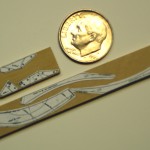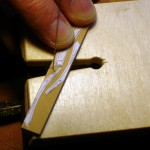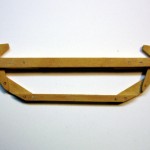 A few of the parts are very small. Don’t sneeze. Some of the parts need to be made in multiples. The strategy for creating multiple identical parts is to glue boards together temporarily. Cut one pattern. Separate the boards. The temporary glue is rubber cement. It holds just well enough to get the job done. The same cement is used to affix paper patterns cut from the plans produced at the start of the project.
A few of the parts are very small. Don’t sneeze. Some of the parts need to be made in multiples. The strategy for creating multiple identical parts is to glue boards together temporarily. Cut one pattern. Separate the boards. The temporary glue is rubber cement. It holds just well enough to get the job done. The same cement is used to affix paper patterns cut from the plans produced at the start of the project.
 Most parts cutting is done with a jeweler’s saw that has teeth so fine as to be barely visible.
Most parts cutting is done with a jeweler’s saw that has teeth so fine as to be barely visible.
The mid-frame is made of seven parts, all quite small. These and many other parts of this boat are small both to minimize weight and to get them from narrow width (inexpensive) lumber.
The frame was assembled directly over the plan. A temporary cross spall is needed to keep the frame at the proper width until the planking is complete. On the 1:1 version, this cross spall is a single piece that can be unscrewed when needed.  For the model, I made the cross spall in a layered assembly that can be readily removed. Trennels, made of bamboo, are substitutes for screws, adding both appearance and strength.
For the model, I made the cross spall in a layered assembly that can be readily removed. Trennels, made of bamboo, are substitutes for screws, adding both appearance and strength.
 While waiting for glue to set up on the mid-frame, I started the bulkheads. Two methods are described for these parts. One method uses lightweight cedar laminated from two 1/4 inch thin layers. Why not a single 1/2 inch construction? Strength while remaining lightweight is the reason. Laminating layers with opposing grain directions adds more strength than if a single layer were used. The alternate construction uses 1/2 plywood as a heavier substitute. I chose the first approach. Here we see patterns applied to boards that have been edge glued together to get to the needed width.
While waiting for glue to set up on the mid-frame, I started the bulkheads. Two methods are described for these parts. One method uses lightweight cedar laminated from two 1/4 inch thin layers. Why not a single 1/2 inch construction? Strength while remaining lightweight is the reason. Laminating layers with opposing grain directions adds more strength than if a single layer were used. The alternate construction uses 1/2 plywood as a heavier substitute. I chose the first approach. Here we see patterns applied to boards that have been edge glued together to get to the needed width.
Click on any image to show a larger version.
Leave a Reply